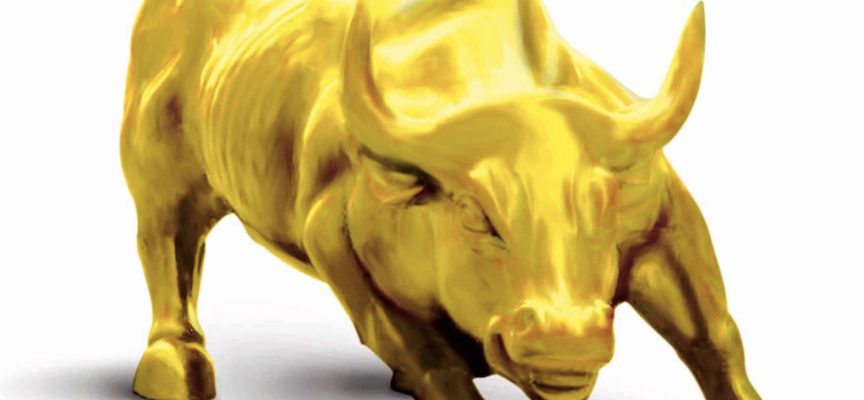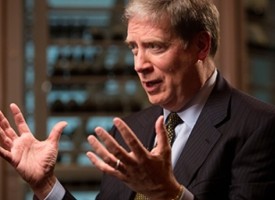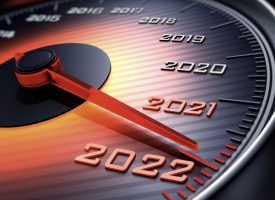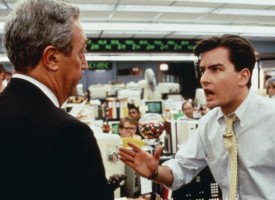As we get ready to kickoff trading in the month of September, today a legend in the business sent King World News a powerful piece predicting that gold will soar 69% within the next 18 months!
American Profligacy and The US Dollar
By John Ing, Maison Placements
August 30 (King World News) – The US dollar has been losing ground and is even lower than when Trump took office, ironically peaking when he said the dollar was too strong. Today he is getting what he wished for. The US dollar has become the worst currency in the world, collapsing due in part to his failure to pass the Healthcare Bill raising doubts whether he can get Congress to approve tax reform which is equally divisive. In addition, the market’s reaction to the Washington gridlock and the daily circus in the White House has eroded confidence in his administration and the US dollar. Then there are the dovish statements from the Federal Reserve which left investors wondering whether a September rate rise is in the offing. Worse, Fed Chair Janet Yellen recently mused that, “I don’t believe we will see another crisis in our lifetime”, ignoring her role in the last Fed-fueled crisis bubble that burst. To be sure, the upcoming “debt mess” discussions and Trump’s shutdown threat adds fuel to the fire…
IMPORTANT:
To find out which company the richest man in China has invested in, one that
Rick Rule and Sprott Asset Management are pounding the table on that
is quickly being recognized as one of the greatest investment
opportunities in the world – CLICK HERE OR BELOW:
Trump’s dueling threats with North Korea raised even more questions but the prospect of a trade action against Beijing, America’s major trading partner has renewed concerns about a major trade war hurting both nations. The debates on trade has caused factional battles within the White House which has not helped confidence in the dollar or the Trump administration. The sinking dollar it seems is simply a reflection of Trump’s fortunes, exacerbated by the “fire and fury” threat which helped push gold to more than a 12 percent gain this year, outperforming most markets.
Today other than immediately after World War II, the United States debt is at the highest ever. Borrowing beyond its means for over a half century, Americans became adept at spending tomorrow’s money. With the US dollar becoming the cornerstone of the global financial system, it has become the world’s biggest borrower, dependent upon foreign nations to finance its profligacy. However, this time, Donald Trump’s promised disruptive change might cause conflicts with its creditors, some of whom are in his crosshairs as “currency manipulators”. America’s creditors which financed over half of its debt have leverage to push back and will not overlook the world’s biggest deficits and surge in spending. The world has never witnessed the present levels of debt. Remember that when Congress must increase the debt ceiling and pass the budget this fall. The United States runs out of money in October.
As pessimism spreads about the financial viability of his economic agenda and starved for a legislative victory, Trump and his team may yet elevate the gold standard discussion which has become an issue among some Wall Street and hedge fund supporters of Trump. Such a move would make for smart politics, as well as smart policy because it would limit the power of the Federal Reserve and government’s penchant to spend. Then again if the status quo remains, gold might continue to be an effective hedge on concerns that the political drama in Washington will eventually impair the government’s ability to function, weighing ever more heavily on the overvalued financial markets.
Debt Trap – A Time Bomb
Against this background, bonds and stocks are overly expensive, inflated by a decade of extraordinary stimulus measures, as trillions of newly minted dollars were created to drive down interest rates to save the banking system. As a result, central banks own a fifth of government total debt and their balance sheets are four times pre-crisis levels. The Fed alone has a $4.5 trillion balance sheet built up by quantitative easing. To be sure, any attempts to “normalize” or reduce the bloated balance sheets by allowing securities to mature or the reinvestment of maturing bonds raises the possibility of massive sales into a market that is ill-prepared to absorb it. Never in monetary history have we had a prolonged period of negative rates. We are in unchartered waters. QE economics have lulled markets into a false sense of security on debt sustainability. After Jackson Hole, expect bond yields to resume their upward trajectory. Moreover, reducing these balance sheets has many consequences.
The entire financial ecosystem has been compromised by a decade of central bank experiments. Bond yields are significantly lower than any possible time value discount giving rise to imbalances and distortions. There is no discipline in the system. Economic theory again shows that it is inevitable that interest rates will rise. Indeed, we have had four rate increases, but in measurable movements. The time value of money and history shows that the ‘normalized” level is perhaps at least double or triple current rates. When that occurs, as inevitable as King Canute’s tide, the massive loss of wealth will be yet another problem that Trump and friends must deal with.
United States is Too Big to Fail
Wall Street has again created and sold new structural products like ETFs, only 10 years after their last creations such as collateralized debt obligations or credit default swaps almost blew up the financial system. The world of exchange traded funds has exploded in size. Today the record breaking inflows into exchange traded funds (ETFs) are fueling fears of over-crowding and that the tide of money is helping to inflate the stock market bubble. We believe Wall Street’s ETFs have emerged as a new asset class and the management of assets “by wire” or passive investment threatens to become the next asset of mass
destruction. ETFs give an illusion of liquidity, but when the $5 billion VanEck’s Junior Gold Mines GDXJ became too big, it faced a structural problem that required a reconfiguration and share consolidation of juniors. Liquidity was an illusion since a restructuring of the portfolio took months to achieve. ETFs have not incorporated the risk that many different participants, follow the same fashion and choose to take positions in the same vehicle in a herd-like manner, the outcome could end badly. Lessons haven’t been learned. Déjà vu.
Risk has also shifted ironically from the private sector to government only a decade after taxpayers bailed out Wall Street and its banks. Amazingly though, it is not the private sector that is exposed, but the government sector with sovereign debt in some cases yielding comparable to junk bonds. Italian junk bonds today yield less than US Treasury units which are supposed to be risk free. No one asks will this debt ever be repaid. History shows that sovereign debt defaults are only too common. There were of course the sovereign debt defaults in the Thirties and in the Eighties, we had the global debt crisis. Argentina has defaulted on its debt six times in the last century. We had defaults in Russia, Asia and Mexico in the Nineties. Debt on debt is not good. Then there is the debt on central banks’ balance sheets at record highs with four of the biggest central banks holding more debt than America’s annual GDP. America’s debt today stands at $20 trillion.
The problem is that this mammoth debt load endangers the global financial system. Central banks are part of the problem. The debt clogged system is poised to burst. And today, amid America’s drift towards fiscal instability, compounded by economic nationalism and protectionist measures, something simple like a botched debt ceiling discussion could swamp the financial system in a nanosecond.
Money itself has come into question. Just ten years ago, banks in London, France and United States were forced to have “bank holidays” as money became a paper credit or IOU after a run on the huge money market funds threatened to paralyze the global banking system. Those funds held mortgages which were cut and diced into derivative tidbits that were found to be worthless. Also those banks were considered too big to fail, such that the government spent trillions to prop up the system. Today sovereign governments are considered too big to fail. But the bailouts of Greece, Iceland and Ireland are lead indicators of the growing conflict and risk. The current political and social meltdown is a symptom that the bubbles created by fiat money and consequent debt issuances cheapens money, increasing risk. Rates are negative, bond buyers remain complacent and central banks, despite rhetoric, remain easy. We thus believe that the dollar is falling, not because the Fed is “tight” but trust in the US has been damaged, which damages the entire world. There was a time when gold was money. In today’s uncertain world, we are not surprised that the yellow metal is back in fashion.
Where Is Inflation?
Despite the printing of trillions of dollars (QE1, QE2, and QE3) over the last eight years, central banks are frustrated over chronically low inflation, though the absence does allow them to keep credit loose. Past history showed that if you printed too much money, that money chased too few goods resulting in higher inflation. Yet another month, another low inflation number. What gives? It is too early to celebrate. In the 60s, 70s, and 80s, inflation was a product of too much money chasing too few goods and for a time – hyperinflation emerged in some countries like Russia, Zimbabwe or Venezuela.
Today trillions of dollars are sitting on the balance sheets of the central banks’ surrogates, the investment banks and commercial banks which have held onto those reserves partly to repay for the sins of the past. That money however fueled bubbles in the stock market and real estate, because of the nominal carrying cost. We believe that after three attempts of experimental quantitative easing, the central bankers and politicians will fall back to their default position of blatant money printing, commonly called “helicopter money”, perhaps in the form of tax cuts where the handouts are this time distributed directly to Main Street rather than the Wall Street bankers. And in unwinding their portfolios, central banks might find it politically expedient to just let the money flow into the economy. The sums are huge which could then lead to very high inflation. That is something that the markets have not discounted.
Another reason for this apparent lack of headline inflation is demographic. Having bought homes, raised children and with multiple cars sitting in the garage, the Baby Boomers have been saving for retirement rather than consume and spend. But when they spend, they rack up cheap debt.
During the Seventies, trillions were used to finance President Johnson’s social spending programs and fight a war resulting in big handouts to the American people. The Baby Boomers took that money and spent resulting in double-digit inflation and Fed Chair Volcker’s bitter double digit medicine. According to the NY Fed, today household debt is at $13 trillion having surpassed the previous peak of the 2007 bubble. After bingeing on credit, using debt to subsidize spending, credit card debt, too hit an all-time peak. Ominously both the Great Recession and Great Depression were preceded by similar run-ups in household debt. In fact, margin debt so far has set four new peaks this year which is an increase of 64 percent from the margin levels of January 2008, the year of the crash.
 Gold Is an Investment in Monetary Disorder
Gold Is an Investment in Monetary Disorder
Gold is a barometer of investor anxiety, a storehouse of value and in time, a hedge against inflation. In recent days, gold has spiked through $1,300, still shy of the $1,940 an ounce high reached in 2011. Like all commodities, gold is subject to supply and demand but steady purchases by major central banks including China and Russia have sopped up physical supplies. We believe the purchases are tied to the expectation that the US, Japan and Western Europe have public debt trajectories that are unsustainable.
This year gold has risen 12 percent. While the consequences of the series of quantitative easing has not been evident, we believe the era has come to an end, drowned beneath the rising tide of overvalued assets. If holding the barbaric metal is irrational, where then is the rationality in dedicating 100 percent to paper assets which are inherently unstable? And inflation is back. There already is a first wave of inflation in hard assets, the stock markets, real estate and vanilla beans because of the abnormally low carry costs. That flood of money has supported another tech bubble with trillion dollar entities resulting in lofty valuations and a herd-like investor greed not to be the last one standing. However, cost pressures are in the offing from wages to energy, and of course depreciating currencies. As such when inflation returns to Main Street, we believe that impetus will push gold to $1,400 an ounce and then $2,200 (a 69% surge) within 18 months.
Also, King World News just interviewed billionaire Eric Sprott who discussed skyrocketing silver and much more and you can listen to the remarkable KWN audio interview with billionaire Eric Sprott by CLICKING HERE OR ON THE IMAGE BELOW.
***KWN has now released the remarkable audio interview with whistleblower and London metals trader Andrew Maguire discussing the US propaganda surrounding Fort Knox, an update on the upcoming 250 tonne physical order for gold and much more, and you can listen to it by CLICKING HERE OR ON THE IMAGE BELOW.
***ALSO JUST RELEASED: Major Warning For This Friday! Plus Spot The Glaring Difference: 1999 vs 2017 CLICK HERE.
© 2017 by King World News®. All Rights Reserved. This material may not be published, broadcast, rewritten, or redistributed. However, linking directly to the articles is permitted and encouraged.










